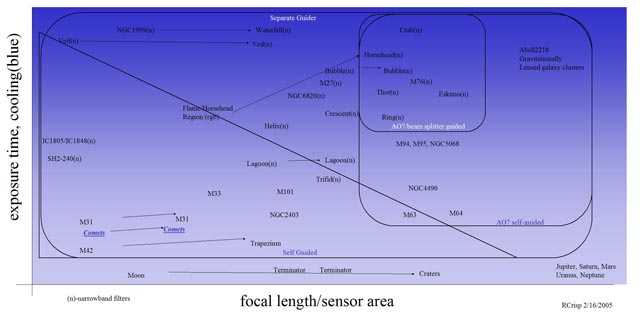
Click to enlarge
n- indicates narrowband filter
Planets, moon are unguided
The chart shows exposure time on the vertical axis
versus focal length on
the horizontal axis (basically equivalent to 1/object size)
To have a constant level of dark noise as exposure time is increased,
cooling should increase. So the vertical axis also includes cooling level as
a blue gradient: the shorter the exposure the less cooling is needed, the
longer the exposure the more cooling is needed; again to maintain the same
level of noise due to accumulating dark current.
In order to properly frame an object you adjust the focal length depending
on the size of the object: the smaller the object the longer the focal
length, the larger the object the smaller the focal length. Since for a
given focal length increasing the sensor size makes the object occupy a
smaller proportion of the total frame, the focal length axis can be
normalized to sensor area which basically gives Field of view (FOV)
With long focal lengths the AO7 is really handy. But it is hard to use
self guided with narrowband filters. So with nebular objects that are small
the beam splitter approach is the best choice.
For small galaxies there is no need for narrowband filters and the insertion
loss of the hot mirror increases exposures so self-guided AO7 is best.
For most large nebulae shot with narrowband emission line filters including Halpha, except
for the shortest focal lengths (camera lenses) it is usually easier to use a
separate guider and guide camera piggybacked atop an imaging refractor. If
you use RGB then it is easier to get away with self guiding.
For very large and very bright objects and most LRGB nebulae and medium size
to larger galaxies, then self guiding is usually not too restrictive.
Mostly I image in the longer focal length area and in the narrowband area
with nearly any focal length. So I tend to use the AO7 for the tiny objects
and may or may not use narrowband filters for those objects. So the filters
determine if I use the beam splitter or self guide with the AO7.
When I narrowband image with the FCT76 through AP180, I use a separate
guider. For that matter I use a separate guider always with those refractors
but there's no reason why self guiding will not work, particularly if the
object is imaged with LRGB filters instead of narrowband.
For camera lens shots, I use self guiding and narrowband filters at the
moment. I usually use 15 second guider exposures but the focal lengths are
so short that little damage can be done in those 15 seconds due to drifting
around.
For lunar and planetary shots there is no guiding and short exposures.
So that's how the chart works. I hope it is useful and helps to clarify the
comments I have made from time to time.